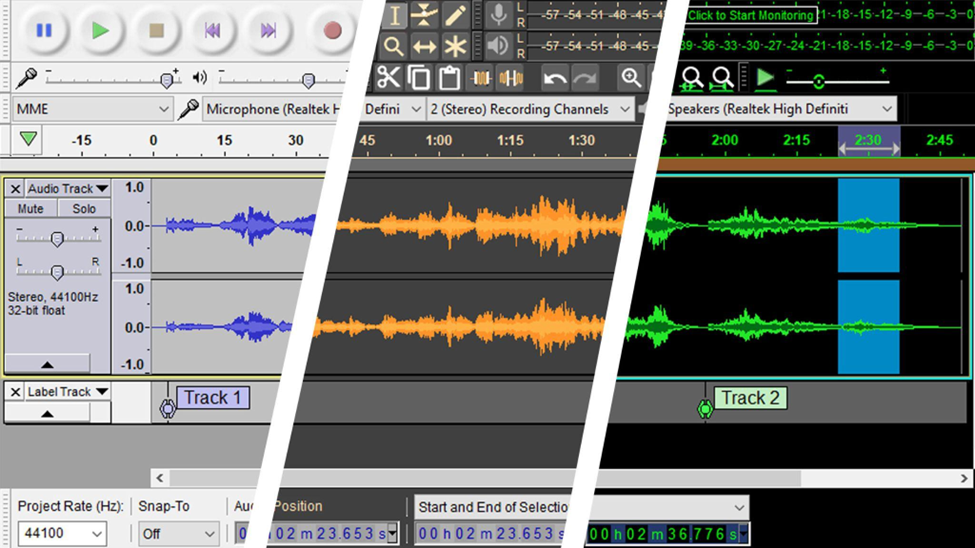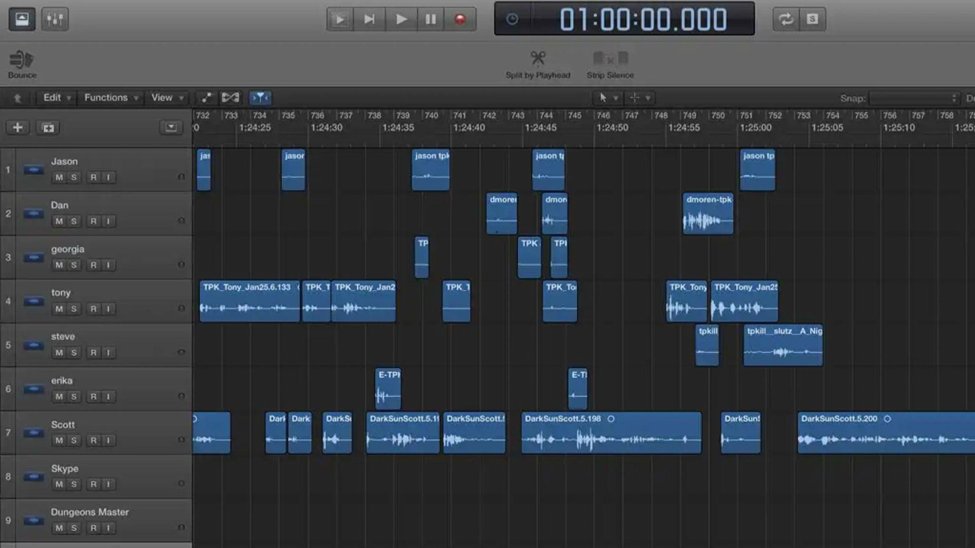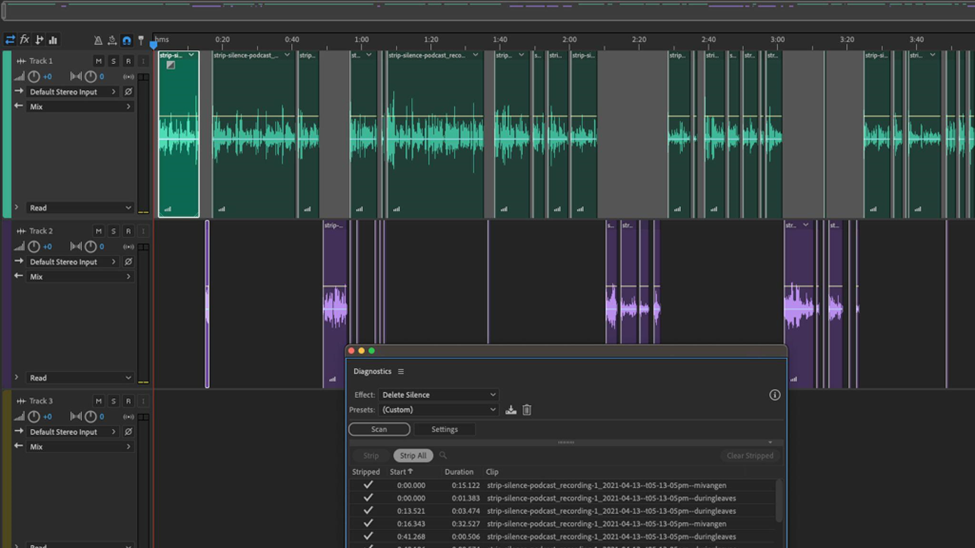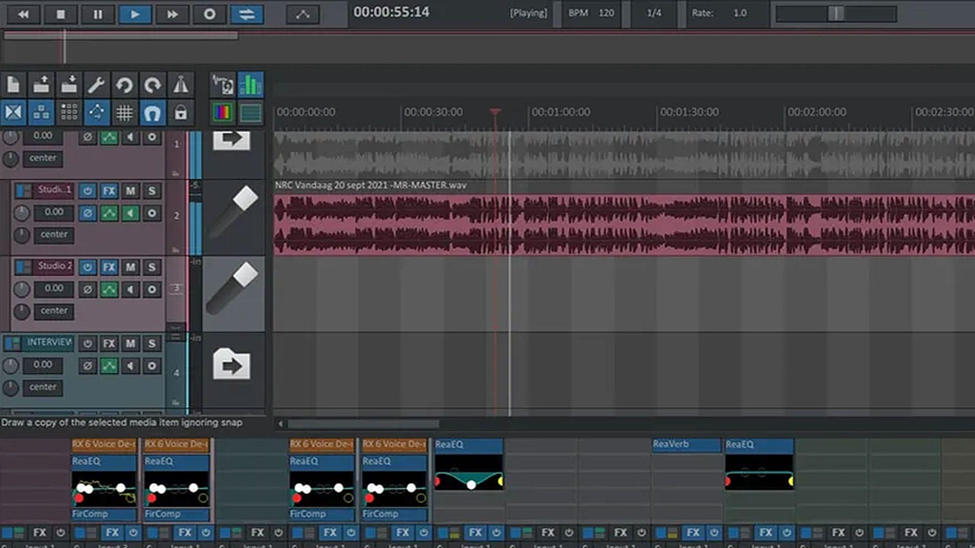Audio editing programs are abundant, and so are opinions on which one is the best for editing podcasts. In reality, desktop audio workstations are seeing a lot of competition from AI-powered, cloud-based studios like Riverside and Alitu. So, now that a new class of podcast editing software is here let’s take an up-to-date look at the most practical podcast editing solutions available to podcasters in 2023.
Free podcast editing software
Audacity

If you’re looking to edit your podcast for free, Audacity is your best choice. Despite its slightly dated interface and inability to automate anything, Audacity has a robust support forum and compatibility with Windows, MacOS, and Linux. It also supports 3rd-party plugins, so you can use state-of-the-art VSTs like iZotope RX to clean and repair your audio.
As the only major open-source podcast editing option available, Audacity continues to earn its place among the ranks of beginner podcasters. Try it out, and when you’re ready for something easier or beefier, upgrade to a different program.
Who is it for? First-timers and zero-budget podcasters.
Bonus tip: Did you know you can skin Audacity with a dark theme?
Garage Band

GarageBand is where MacOS users generally start their podcasting journey, simply because it comes bundled with the operating system of every new Mac. It comes with the two built-in effects all podcasters use - compression and EQ - and a lot more features for creative editing.
Despite its music-focused design, GarageBand is perfectly suitable for editing podcast audio. Using music loops to create intros and outros is drag-and-drop simple. Podcasters looking for more than the most basic of features, however, will want to move on pretty quickly. For a frictionless next step, get Logic Pro. It’s the big brother of Garage Band, sharing its interface and workflow but with a lot more functionality.
Who is it for? First-timers and zero-budget podcasters on MacOS.
Subscription (paid) podcast editing software
Adobe Audition

Audition’s main benefit is its participation in the Adobe ecosystem. You can quickly port the audio from your show into After Effects to create an audiogram or download intro music from the Adobe library.
Audition also contains the best out-the-box audio repair tools for any desktop audio workstation. Features like Auto Heal and Denoise are included in the software, making similar 3rd-party apps unnecessary. Quick and easy audio repair for those poor-quality guest phone calls.
On the downside, Audition is a little more expensive than it needs to be for what it does. If you’re looking for a podcast editing software fix that doesn’t break the bank, move along.
Who is it for? Podcasters with a healthy budget who are existing users of Adobe products.</em >
Bonus tip: Check out Adobe’s free AI-powered podcast speech enhancer tool. You can use it to correct poorly recorded audio. Upload your files, wait for the processing to complete, and then click Play to download your full file. Find the V.2 version here.
Hindenburg

Hindenburg’s focus on ease of use makes it a favourite with many podcasters, particularly journalists. Why? Journalists typically use far more audio sources than a standard talk show podcast. Hindenburg famously auto-levels every clip you drag into it, normally making volume automation unnecessary. The program has in the past acted buggy when dealing with VSTs, and the interface isn’t amazing. But is a growing source of relief for busy podcast editors who edit stories with many different threads.
Who is it for? Podcasters with a budget who typically edit a complex array of audio.</em >
Reaper

Reaper has won the hearts of many editors as the budget-friendly, feature-packed underdog of the podcasting and music world. For the price, Reaper is an absolute beast that rivals even the mighty ProTools in features and customization options. The community support is inspirational, and there’s even a dedicated Reaper for Podcasting</a > channel.
The drawback? There’s a little bit of a hill to climb while unlocking its power. Podcasters who want a quick and easy solution might have to do a bit of research before earning their time-saving tactics. But once they do, there’s no better value for money in the podcast editing world.
Who is it for? Tech-savvy podcast editors who want workflow optimization.</em >
ProTools

Some podcast editors may use ProTools, but it’s not a widely purchased software suite unless you also make commercial music. As the longtime standard of the music industry, ProTools has a bit of a chokehold on anyone looking to produce music. And for good reason. It’s an absolute powerhouse of a program with plenty of features and broad hardware compatibility. But is it worth the price to edit a couple of VO files and some intro music? Unless you’re producing a show with 500 guests, probably not.
Who is it for? Commercial music producers with a huge budget.
Honourable mentions
Here are a few additional podcast software editing options that haven’t been featured in this post.
- Logic Pro X: designed for music production but popular with podcasters on MacOS
- Descript: originally a transcription service, now a cloud studio and editing suite
- Squadcast: cloud studio for teams that manage multiple podcasts
- Ableton Live: music production workstation with satisfactory podcasting capabilities
- iZotope RX: industry-standard suite of audio repair and processing tools
Conclusion
Blog posts like these can help you narrow down the options for podcast editing software. But as with any job, your tools are only as good as how you use them. So if you’re looking to start a brand new show for the first time, keep it simple.
That might mean spending a few bucks a month for an easy-to-use cloud-based editing service, or it might mean spending time learning how to use an audio workstation for your podcast editing.
Whatever you choose, you’re going to need two things to be a podcaster: a hosting service and a bit of help. That’s where Saspod comes in! Start your free Saspod trial today and let our team help you on your podcasting journey. Why make it harder than it has to be?
FAQ
Podcasters typically use a range of software and (increasingly) hardware devices and online “cloud studios” to record their shows. The most common desktop audio recording programs are called Digital Audio Workstations (DAWs). Typical DAWs used to record podcasts include Audacity, Adobe Audition, Reaper, Hindenburg and Logic Pro.
While most DAWs are designed for music production, they can all also be used to record voices, edit intro music and insert audio clips from other sources. Podcasters use the programs listed in this article to record themselves speaking and edit that together with other sound clips and music.
The most widely praised paid audio workstation for podcasting is Adobe Audition. The most widely praised free program is Audacity. However, choosing a program depends on whether you want your podcast editing to be easy and convenient or powerful and flexible. Want more help starting your podcast journey?
Sign up for a Saspod account today and get customer support along the way.
Bogdan Bratis
CEO & Founder of Saspod. Podcast Producer & Digital Marketing Expert. I'm based in Glasgow, where on the side I play keyboard in function bands throughout Scotland, and I'm addicted to coffee.


Comments
No comments yet!